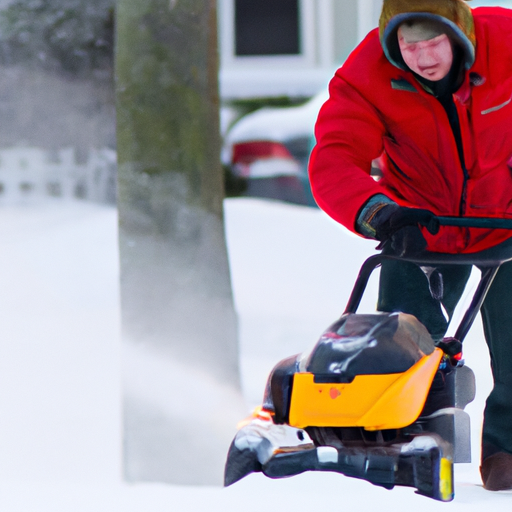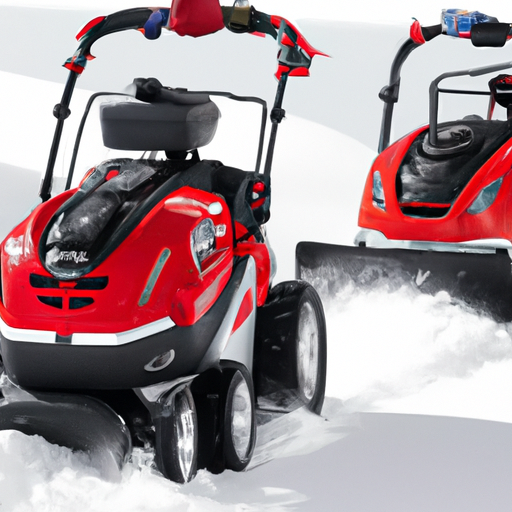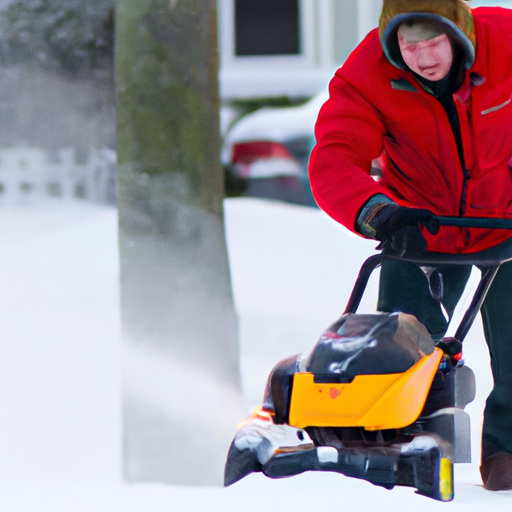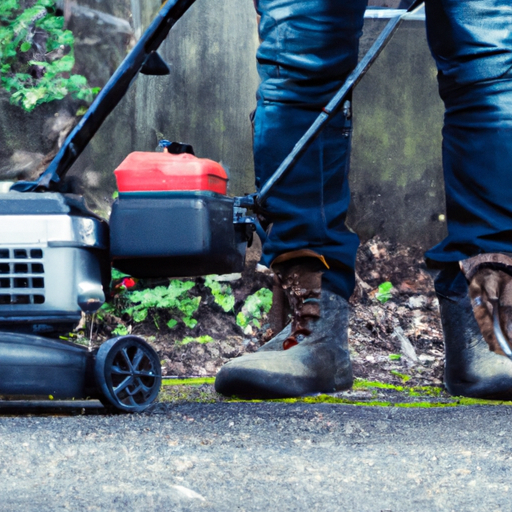Winter is here and you know what that means – snow, snow, and more snow! But don’t worry, we’ve got you covered. Have you ever wondered how to use a battery-powered snow blower safely? Well, look no further because we have all the tips and tricks you need right here. In this article, we’ll walk you through the proper way to use a battery-powered snow blower to make your winter clean-up a breeze. So, let’s dive in and get started!
When it comes to using a battery-powered snow blower, safety should always be your top priority. Before you even begin, make sure you are familiar with the user manual and all the safety guidelines provided by the manufacturer. It’s also important to dress appropriately for the task – wear sturdy boots, warm clothing, and safety glasses to protect your eyes from flying debris. In addition, clear the area of any obstacles, such as rocks or branches, that could potentially damage the machine or cause accidents.
Now that you’ve taken all the necessary safety precautions, it’s time to get down to business. Start by checking the battery and ensuring it is fully charged before you begin. If the battery is low, you may not have enough power to effectively clear the snow, so it’s best to charge it beforehand. Once the battery is ready, turn on the snow blower, taking care to keep your hands and feet away from the rotating parts. Slowly guide the machine along the path you want to clear, being mindful of any uneven terrain or hidden objects. And remember, if you encounter any difficulties or the snow blower gets clogged, always turn it off and safely remove the obstruction before continuing.
By following these simple guidelines, you can confidently tackle the task of clearing snow with a battery-powered snow blower. We hope this article has provided you with valuable insights on how to use this equipment safely. Stay tuned for more helpful tips and tricks in our upcoming articles. Stay warm and stay safe!
Selecting the Right Battery-Powered Snow Blower
When it comes to selecting a battery-powered snow blower, there are a few important factors to consider. The size and power of the snow blower are crucial in determining its effectiveness in clearing snow. A larger and more powerful snow blower will be able to handle heavier snowfalls and clear larger areas in less time. So, before making a purchase, assess the average amount of snowfall in your area and the size of the area you need to clear.
Additionally, it is essential to choose a snow blower that comes with a rechargeable battery. This eliminates the need for cords and makes the snow blower more convenient to use. Look for a model that offers a battery with a longer run time, so you won’t have to stop in the middle of clearing to recharge. This will save you time and ensure that you can complete the task efficiently.
Lastly, consider additional features such as an adjustable chute and speed settings. An adjustable chute allows you to control the direction in which snow is thrown, making it easier to clear walkways or driveways without throwing snow onto unwanted areas. Speed settings allow you to adjust the power of the snow blower according to the depth and density of the snow. These additional features can greatly enhance your snow-clearing experience.
Preparing the Snow Blower for Use
Before using a battery-powered snow blower, it is crucial to read the instruction manual thoroughly. The manual will provide you with important information on how to operate the snow blower safely and effectively. It will also outline any specific maintenance or troubleshooting guidelines that need to be followed.
After familiarizing yourself with the manual, thoroughly inspect the snow blower for any damages. Check for any loose parts or signs of wear and tear. If you notice any damage, it is best to get it repaired before using the snow blower. Using a damaged machine can be unsafe and may lead to further complications.
Another essential step in preparing the snow blower for use is ensuring that the battery is fully charged. A fully charged battery will provide optimal performance and allow you to clear snow without any interruptions. So, make sure to charge the battery for the recommended time before starting.

Safety Gear and Precautions
When operating a snow blower, it is crucial to wear appropriate clothing and protective gear to ensure your safety. This includes wearing warm clothing, gloves, and sturdy boots. Additionally, consider wearing safety goggles to protect your eyes from any debris that may be thrown up by the snow blower.
Before starting the snow blower, clear the area from any obstacles or debris. Remove any large rocks, branches, or toys that may obstruct the path of the snow blower. This will prevent any damage to the machine and ensure a smooth and efficient snow-clearing process. Be cautious of any hidden obstacles such as uneven surfaces or hidden objects buried beneath the snow.
It is also important to avoid using the snow blower on steep slopes. Battery-powered snow blowers are not designed for use on slopes, as it can become unstable and pose a risk to your safety. Stick to using the snow blower on flat surfaces where it can operate efficiently and safely.
Starting and Operating the Snow Blower
Before starting the snow blower, position it in the right direction. Ensure that the chute is facing away from any people or objects to avoid throwing snow in an unintended direction. Once in position, hold the handle firmly with both hands, maintaining a stable grip.
Engage the snow blower by following the instructions in the manual. Some models may require you to push a button or pull a lever to start the machine. Once engaged, adjust the speed settings according to the depth and density of the snow. Higher speeds are suitable for heavy and compacted snow, while lower speeds work well for lighter snowfall.
When operating the snow blower, it is important to move at a steady pace. Avoid rushing or going too slow, as this can affect the efficiency of the machine. Maintain a consistent speed, allowing the snow blower to clear the snow effectively.

Efficient Snow Clearing Techniques
To maximize the effectiveness of a battery-powered snow blower, it is important to follow efficient snow clearing techniques. Start with lighter and smaller accumulations of snow before tackling heavier sections. This will help prevent clogging and allow the snow blower to clear the snow more effectively.
When clearing snow, work in sections, overlapping each pass slightly. This ensures that no snow is left behind and helps create a clean and even surface. It is also important to utilize the chute direction to control the snow throwing. Adjust the chute angle according to the direction you want the snow to be thrown, ensuring that it is away from any walkways or driveways.
Dealing with Clogged Auger or Chute
Despite following efficient snow clearing techniques, there may be instances where the auger or chute of the snow blower gets clogged. In such cases, it is important to switch off the snow blower immediately to prevent any accidents. Disconnect the battery to ensure that the machine cannot be accidentally started.
Once the snow blower is switched off and the battery is disconnected, clear any clogs using a snow clearing tool. Avoid using your hands or feet to remove obstructions, as this can cause injury. Use a shovel or a specialized tool provided with the snow blower to safely remove any clogs.
Maintenance and Storage
After each use, it is important to clean the snow blower to prevent any buildup of debris or snow. Use a brush or a cloth to remove any snow or dirt from the machine. Pay special attention to the chute and auger area, as these are the parts most susceptible to clogging.
Regularly inspect the snow blower for any worn-out or damaged parts. Replace any parts that show signs of wear and tear to ensure the optimal performance of the machine. Following the manufacturer’s maintenance guidelines will help prolong the lifespan of the snow blower and ensure its safe operation.
When it comes to storing the snow blower, choose a dry and safe location. Avoid exposing the machine to extreme temperatures or moisture, as this can damage the electrical components. Store the snow blower in a covered area, such as a garage or shed, to protect it from the elements.
Common Troubleshooting Tips
If you encounter any issues while using the battery-powered snow blower, there are a few troubleshooting tips you can follow. Firstly, check the battery level and connections. Ensure that the battery is fully charged and securely connected to the snow blower. A loose connection can cause the snow blower to stop working.
Additionally, ensure that the snow blower is free from debris. Clear any snow or dirt that may have accumulated on the machine, as this can affect its performance. Use a brush or cloth to clean the snow blower thoroughly.
If problems persist, consult the manufacturer’s troubleshooting guide. The guide will provide you with specific instructions on how to address common issues. Following these guidelines will help you identify and resolve any problems effectively.
Safety Tips for Battery Charging
When it comes to charging the battery of a snow blower, it is important to follow proper safety precautions. Always use the specific charger provided with the snow blower, as using a different charger can damage the battery or the machine. Charge the battery in a well-ventilated area, away from flammable materials.
Avoid overcharging the battery, as this can reduce its lifespan and potentially cause damage. Monitor the charging process and disconnect the battery once it reaches its recommended charge level. This will ensure optimal performance and longevity of the battery.
During storage, it is important to store the battery in a cool and dry location. Extreme temperatures can affect the battery’s performance and shorten its lifespan. Keep the battery away from direct sunlight and moisture to prevent any damage.
Conclusion
Using a battery-powered snow blower can greatly simplify the task of clearing snow. By following the outlined guidelines, you can safely and effectively use a battery-powered snow blower to clear snow. Always prioritize your safety and be cautious while operating the machine. With the right equipment, proper preparation, and safe practices, clearing snow can become a quicker and easier task. So, gear up, charge your battery, and get ready to tackle those snowy days with confidence!


